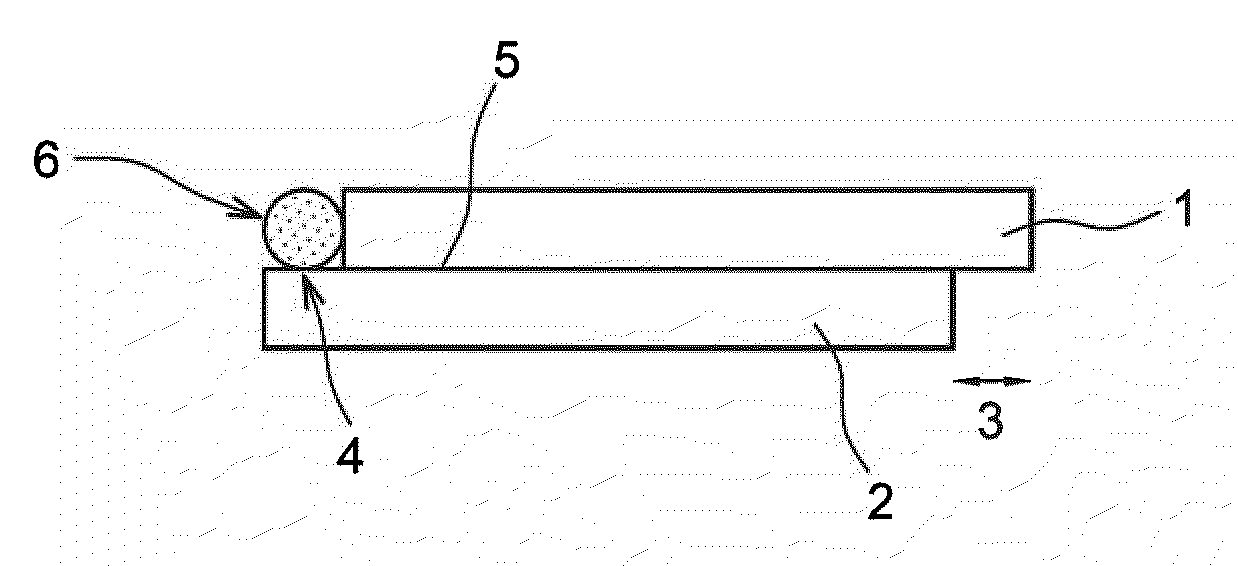Process for the Moderately Refractory Assembling of Articles Made of SiC-Based Materials by Non-Reactive Brazing, Brazing Compositions, and Joint and Assembly Obtained by this Process
- Summary
- Abstract
- Description
- Claims
- Application Information
AI Technical Summary
Benefits of technology
Problems solved by technology
Method used
Image
Examples
example 1
[0176]This example describes applied-drop tests performed with a brazing alloy or brazing composition according to the invention having the composition: 59% by mass of Si and 41% by mass of Y on sintered pure α-SiC, by applying a single brazing stage at 1255° C. and at 1270° C.
[0177]a) Preparation of the Brazing Composition and of the Brazing Paste
[0178]The braze having the targeted composition: 59% by mass of Si and 41% by mass of Y, was prepared from Si powder and from YSi2 powder.
[0179]These powders were weighed out according to the proportions of the brazing composition. They were then mixed together in a Turbula for at least 30 minutes to obtain a homogeneous powder mixture.
[0180]An organic binder (Nicrobraz® cement) was added to this powder mixture in order to form a viscous paste.
[0181]b) “Applied Drop” Test at 1255° C.
[0182]The brazing paste thus prepared is used to form a small lump of braze with a mass of about 50 mg. This lump of braze is placed on a precleaned SiC plate....
example 2
[0192]This example describes applied-drop tests performed with a brazing composition or brazing alloy according to the invention having the composition: 59% by mass of Si and 41% by mass of Y on sintered pure α-SiC, by applying a brazing stage at 1270° C., preceded by a stage at 1135° C.
[0193]a) Preparation of the Brazing Composition and of the Brazing Paste
[0194]The brazing composition and the brazing paste were prepared as described in Example 1.
[0195]b) Applied-Drop Test
[0196]The brazing paste thus prepared is used to form a small lump of braze with a mass of about 50 mg. This lump of braze is placed on a precleaned SiC plate.
[0197]The lump of braze and the plate are together placed in a brazing oven and subjected to a brazing heating cycle under a secondary vacuum, which comprises two stages:[0198]a first stage of 90 minutes at 1135° C.;[0199]a second stage, which is the brazing stage, at 1270° C.
[0200]The lump of braze melts during this heat treatment and forms an “applied drop...
example 3
[0203]This example describes applied-drop tests performed with a brazing composition or brazing alloy according to the invention having the composition: 59% by mass of Si and 41% by mass of Y on carbon-bearing sintered pure α-SiC, by applying a brazing stage at 1270° C., preceded by a stage at 1135° C.
[0204]The deposition of carbon may be performed by chemical or physical vapour deposition—CVD or PVD—or by rubbing with a graphite lead. The carbon content is between 0.1 mg / cm2 and 1 mg / cm2. For this sample, a graphite lead was used.
[0205]a) Preparation of the Brazing Composition and of the Brazing Paste
[0206]The brazing composition and the brazing paste were prepared as described in Example 1.
[0207]b) Applied-Drop Test
[0208]The brazing paste thus prepared is used to form a small lump of braze with a mass of about 50 mg. This lump of braze is placed on a precleaned SiC plate.
[0209]The lump of braze and the plate are together placed in a brazing oven and subjected to a brazing heating ...
PUM
| Property | Measurement | Unit |
|---|---|---|
| Temperature | aaaaa | aaaaa |
| Temperature | aaaaa | aaaaa |
| Temperature | aaaaa | aaaaa |
Abstract
Description
Claims
Application Information
 Login to View More
Login to View More - R&D
- Intellectual Property
- Life Sciences
- Materials
- Tech Scout
- Unparalleled Data Quality
- Higher Quality Content
- 60% Fewer Hallucinations
Browse by: Latest US Patents, China's latest patents, Technical Efficacy Thesaurus, Application Domain, Technology Topic, Popular Technical Reports.
© 2025 PatSnap. All rights reserved.Legal|Privacy policy|Modern Slavery Act Transparency Statement|Sitemap|About US| Contact US: help@patsnap.com


